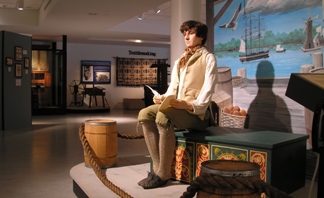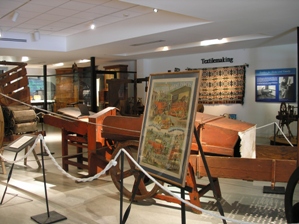About Us
Mission Statement: The Schwenkfelder Library & Heritage Center, with its internationally recognized collections and research facilities, engages visitors in exploration of the themes of religious freedom, tolerance, migration, and heritage in their own lives and the lives of their families through the stories of the Schwenkfelders and the Pennsylvania Germans of the Perkiomen region - people whose bonds of faith, family, and community tell a fundamental American story.
Explore the history, art, genealogy and spirituality of the Perkiomen Valley. Journey from 16th century Germany to present day Pennsylvania.
Read all about us in our blog!
The Schwenkfelder History Gallery
We are the only institution preserving and interpreting the story of the Schwenkfelders. Because of that, we have a long term exhibit telling this story. The Schwenkfelder exhibit begins just past the stairs to the lower level, along the ramp, with the story of Caspar Schwenckfeld von Ossig and his participation in the Protestant Reformation.
Caspar Schwenckfeld von Ossig

Like many of his contemporaries, Schwenckfeld pondered the question of the Lord's Supper. The numerous Christian groups springing up in Europe clashed over the meaning and practice of this most holy of Christian observances. Schwenckfeld sought the inner spiritual truth that would lead Christians to real understanding of the Lord's Supper. His radical ideas led to his split with Luther in 1526, and set him on his spiritual course known as the Middle Way. Schwenckfeld and his supporters joined in a suspension of the celebration of the Lord's Supper, until all participants could come together in Christian unity. The resulting disputes forced Schwenckfeld into voluntary exile from Silesia in 1529. Often called a heretic and harassed by his enemies, he sought safe houses where he could work and write until his death in 1561.
To this day Schwenckfeld's followers learned of his ideas through his writings or by word-of-mouth. They were generally nobles or intellectuals and Schwenckfeld probably considered them his social equals. Later Schwenkfelders were typical of the general population, including craftsmen and farmers. Schwenkfelders generally lived in two areas -- southern Germany and lower Silesia. Lower Silesia would become their traditional home, and the area where their beliefs would take root. Approximately 1200 to 1500 Schwenkfelders lived in this area.
Immigration

In the early 1720s appeals were made in Vienna for toleration, but were rejected. By 1726, many of the families were desperate to escape. Their leaders secretly contacted Count Nicholas Ludwig von Zinzendorf in Berthelsdorf, Saxony, for shelter. Four years before, Zinzendorf had provided a home to the Moravians, another Protestant sect. Beginning in February 1726 and continuing into the following months, families quietly crept from their homes in Harpersdorf at night. Over 500 of the faithful would take this fateful path. They fled with only the clothes on their backs and a few hand carried items, across the border to Saxony and their unknown future.
They decided to settle in Pennsylvania, already home to German immigrants and others seeking religious freedom. They arrived at the port of Philadelphia in six migrations from 1731 to 1737. The largest group of Schwenkfelders set sail on the St. Andrew from Haarlem, Holland in June, 1734. After a grueling and often tragic voyage, they landed at Philadelphia on September 22, 1734. On the following day, the Schwenkfelder men over age 16 took an oath of allegiance to the British crown, either by signing the oath or by a handshake. George Weiss, a self-educated Schwenkfelder pastor, held the first Day of Remembrance, or Gedaechtnisz-Tag, on September 24. Each year on the Sunday closest to September 24, Schwenkfelders gather to honor their past. While sharing the simple meal of bread and butter, apple butter and water, today's Schwenkfelders remember what the immigrants endured for their faith. Gedächtnestag is the oldest continually celebrated day of thanksgiving in the United States.
Schwenkfelder Life in America


